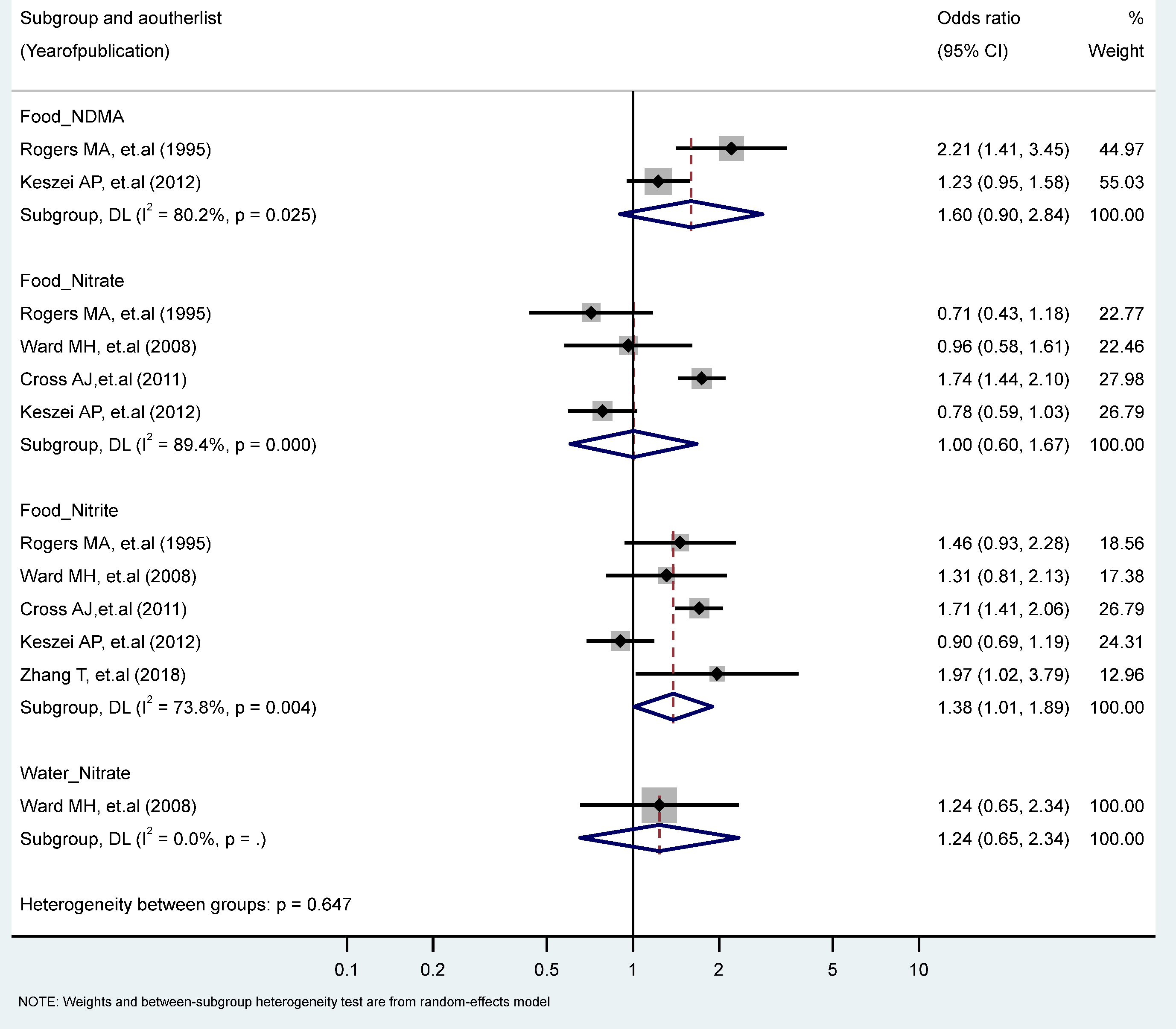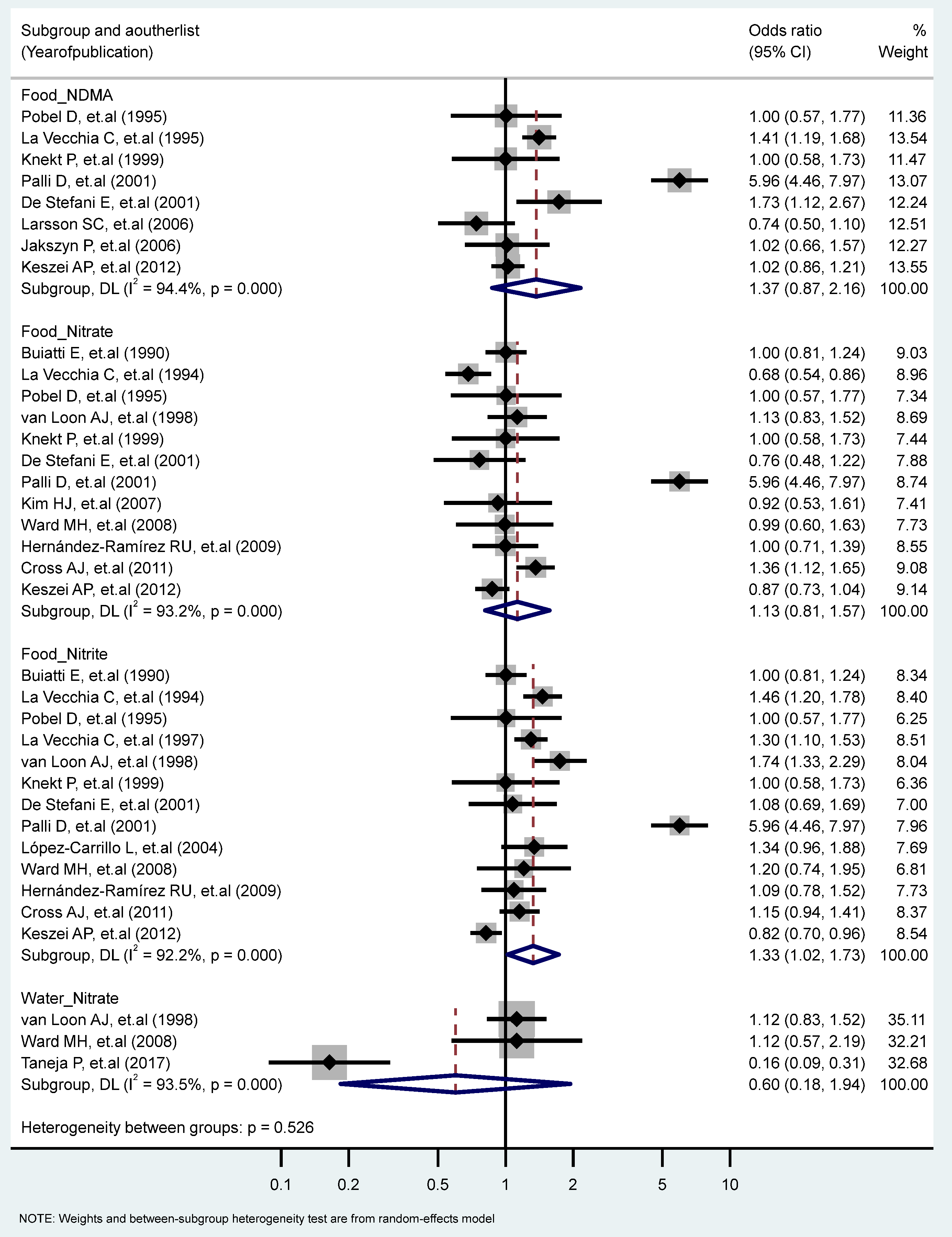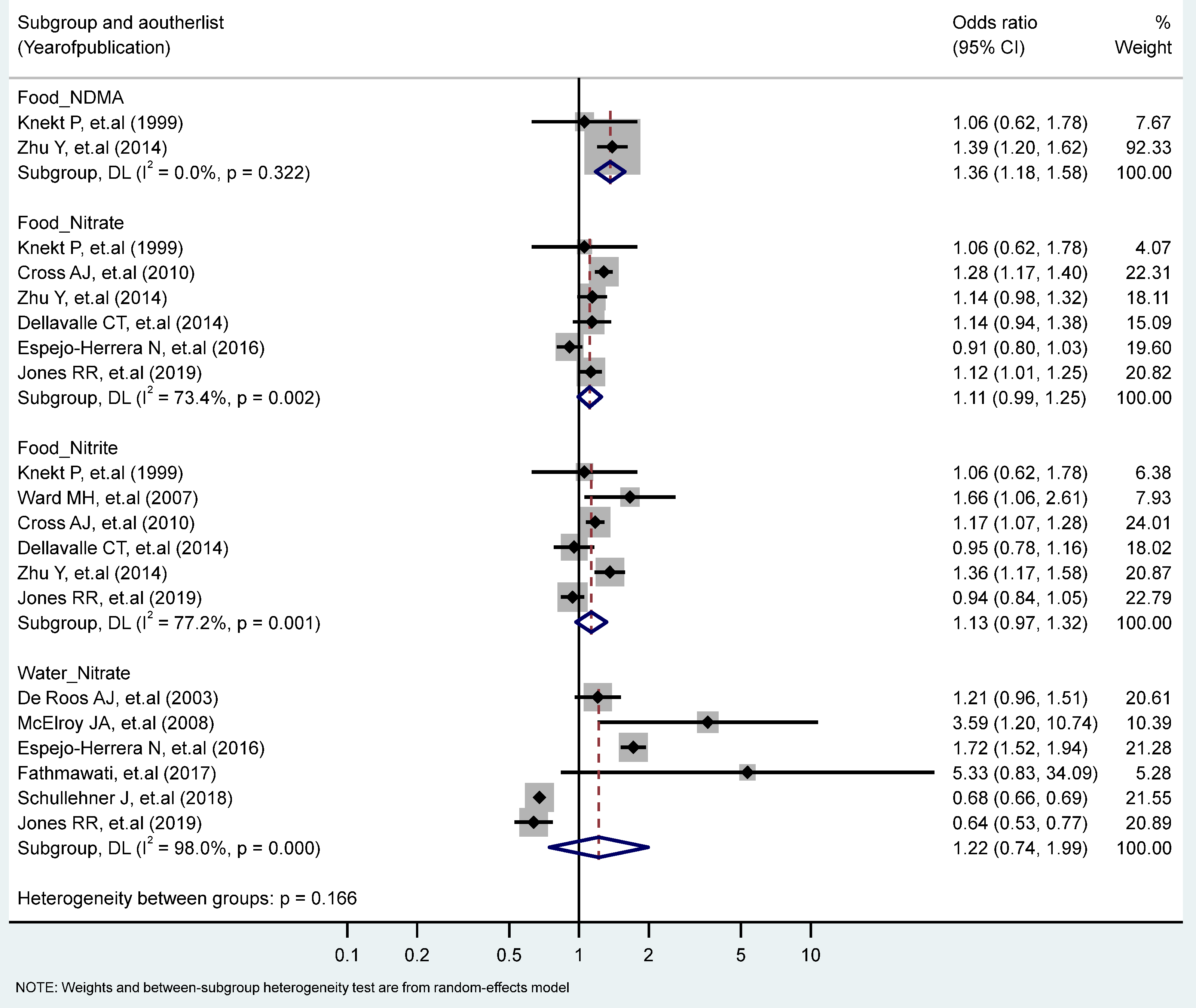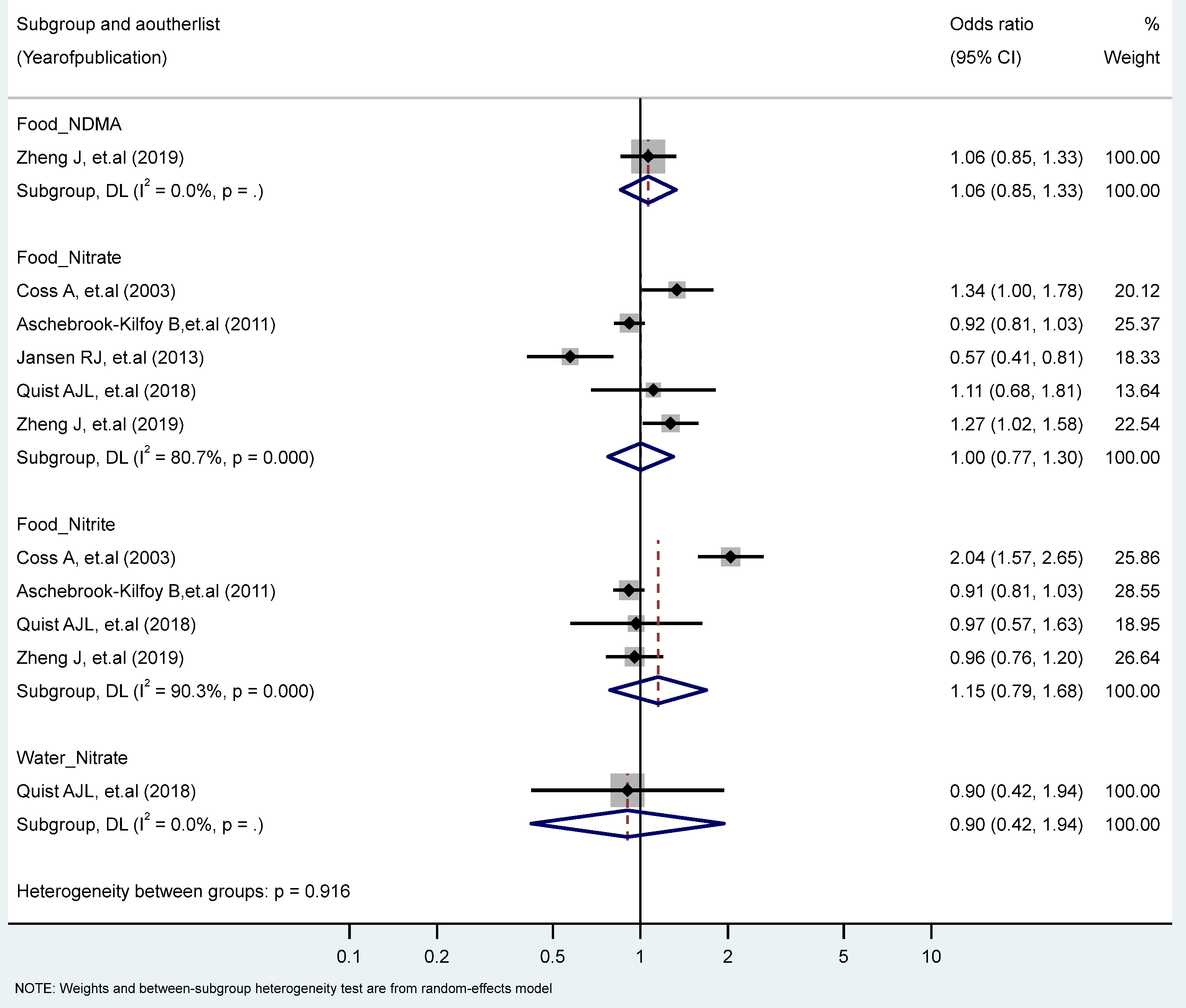Association of Dietary Nitrate, Nitrite, and N-Nitroso Compounds Intake and Gastrointestinal Cancers: A Systematic Review and Meta-Analysis
Abstract
1. Introduction
2. Materials and Methods
2.1. Data Sources, Search Strategy, and Selection Criteria
2.2. Data Extraction and Quality Assessment
2.3. Quality Assessment
2.4. Statistical Analysis
3. Results
Meta-Analysis
4. Discussion
4.1. Esophageal Cancer
4.2. Gastric Cancer
4.3. Colorectal Cancer
4.4. Pancreatic Cancer
5. Conclusions
Supplementary Materials
Author Contributions
Funding
Institutional Review Board Statement
Informed Consent Statement
Data Availability Statement
Conflicts of Interest
References
- Sung, H.; Ferlay, J.; Siegel, R.L.; Laversanne, M.; Soerjomataram, I.; Jemal, A.; Bray, F. Global Cancer Statistics 2020: GLOBOCAN Estimates of Incidence and Mortality Worldwide for 36 Cancers in 185 Countries. CA Cancer J. Clin. 2021, 1, 209–249. [Google Scholar] [CrossRef] [PubMed]
- Tabatabaiefar, M.A.; Moridnia, A. Gastrointestinal Cancers. In Cancer Genetics and Psychotherapy; Mehdipour, P., Ed.; Springer: Cham, Switzerland, 2017. [Google Scholar] [CrossRef]
- Neagoe, A.; Molnar, A.M.; Acalovschi, M.; Seicean, A.; Serban, A. Risk factors for colorectal cancer: An epidemiologic descriptive study of a series of 333 patients. Rom. J. Gastroenterol. 2004, 13, 187–193. [Google Scholar] [PubMed]
- Capasso, M.; Franceschi, M.; Rodriguez-Castro, K.I.; Crafa, P.; Cambiè, G.; Miraglia, C.; Barchi, A.; Nouvenne, A.; Leandro, G.; Meschi, T.; et al. Epidemiology and risk factors of pancreatic cancer. Acta Biomed. 2018, 89, 141–146. [Google Scholar] [PubMed]
- Domper Arnal, M.J.; Ferrández Arenas, Á.; Lanas Arbeloa, Á. Esophageal cancer: Risk factors, screening and endoscopic treatment in Western and Eastern countries. World J. Gastroenterol. 2015, 21, 7933–7943. [Google Scholar] [CrossRef] [PubMed]
- Yusefi, A.R.; Bagheri Lankarani, K.; Bastani, P.; Radinmanesh, M.; Kavosi, Z. Risk Factors for Gastric Cancer: A Systematic Review. Asian Pac. J. Cancer Prev. 2018, 19, 591–603. [Google Scholar]
- Tricker, A.R.; Preussmann, R. Carcinogenic N-nitrosamines in the diet: Occurrence, formation, mechanisms and carcinogenic potential. Mutat. Res. 1991, 259, 277–289. [Google Scholar] [CrossRef]
- Griesenbeck, J.S.; Steck, M.D.; Huber, J.C., Jr.; Sharkey, J.R.; Rene, A.A.; Brender, J.D. Development of estimates of dietary nitrates, nitrites, and nitrosamines for use with the short willet food frequency questionnaire. Nutr. J. 2009, 8, 16. [Google Scholar] [CrossRef]
- Mahvi, A.A.H.; Nouri, J.; Babaei, A.A.; Nabizadeh, R. Agricultural activities impact on groundwater nitrate pollution. Int. J. Environ. Sci. Technol. 2005, 2, 41–47. [Google Scholar] [CrossRef]
- Wogan, G.; Tannenbaum, S. Environmental N-Nitroso Compounds: Implications for Public Health. Toxicol. Appl. Pharmacol. 1975, 31, 375–383. [Google Scholar] [CrossRef]
- IARC Working Group on the Evaluation of Carcinogenic Risks to Humans. Ingested Nitrate and Nitrite, and Cyanobacterial Peptide Toxins. In IARC Monographs on the Evaluation of Carcinogenic Risks to Humans; International Agency for Research on Cancer: Lyon, France, 2010; Volume 94, p. 448. [Google Scholar]
- Li, Y.; Hecht, S.S. Metabolism and DNA Adduct Formation of Tobacco-Specific N-Nitrosamines. Int. J. Mol. Sci. 2022, 23, 5109. [Google Scholar] [CrossRef]
- Li, Y.; Hecht, S.S. Metabolic Activation and DNA Interactions of Carcinogenic N-Nitrosamines to Which Humans Are Commonly Exposed. Int. J. Mol. Sci. 2022, 23, 4559. [Google Scholar] [CrossRef]
- Lijinsky, W. Carcinogenicity and mutagenicity of N-nitroso compounds. Mol. Toxicol. 1987, 1, 107–119. [Google Scholar]
- Jain, D.; Chaudhary, P.; Varshney, N.; Janmeda, P. Carcinogenic effects of N-nitroso compounds in the environment. Environ. Conserv. J. 2020, 21, 25–41. [Google Scholar] [CrossRef]
- Wylie, L.J.; Park, J.W.; Vanhatalo, A.; Kadach, S.; Black, M.I.; Stoyanov, Z.; Schechter, A.N.; Jones, A.M.; Piknova, B. Human skeletal muscle nitrate store: Influence of dietary nitrate supplementation and exercise. J. Physiol. 2019, 597, 5565–5576. [Google Scholar] [CrossRef] [PubMed]
- SeyyedSalehi, M.S.; Mohebbi, E.; Sasanfar, B.; Toorang, F.; Zendehdel, K. Dietary N-nitroso compounds intake and bladder cancer risk: A Systematic Review and Meta-Analysis. Nitric Oxide 2021, 115, 1–7. [Google Scholar] [CrossRef] [PubMed]
- Essien, E.E.; Abasse, K.S.; Côté, A.; Mohamed, K.S.; Ashraf Baig, M.M.F.; Habib, M.; Naveed, M.; Yu, X.; Xie, W.; Jinfang, S.; et al. Drinking-Water Nitrate and Cancer Risk: A Systematic Review and Meta-analysis. Arch. Environ. Occup. Health 2020, 3, 51–67. [Google Scholar] [CrossRef] [PubMed]
- Xie, L.; Mo, M.; Jia, H.X.; Liang, F.; Yuan, J.; Zhu, J. Association between dietary nitrate and nitrite intake and specifc cancer risk: Evidence from observational studies. Oncotarget 2016, 7, 56915–56932. [Google Scholar] [CrossRef] [PubMed]
- Hosseini, F.; Majdi, M.; Naghshi, S.; Sheikhhossein, F.; Djafarian, K.; Shab-Bidar, S. Nitrate-nitrite exposure through drinking water and diet and risk of colorectal cancer: A systematic review and meta-analysis of observational studies. Clin. Nutr. 2020, 40, 3073–3081. [Google Scholar] [CrossRef] [PubMed]
- Zhang, F.X.; Miao, Y.; Ruan, J.G.; Meng, S.P.; Dong, J.D.; Yin, H.; Huang, Y.; Chen, F.R.; Wang, Z.C.; Lai, Y.F. Association Between Nitrite and Nitrate Intake and Risk of Gastric Cancer: A Systematic Review and Meta-Analysis. Med. Sci. Monit. 2019, 25, 1788–1799. [Google Scholar] [CrossRef] [PubMed]
- Song, P.; Wu, L.; Guan, W. Dietary Nitrates, Nitrites, and Nitrosamines Intake and the Risk of Gastric Cancer: A Meta-Analysis. Nutrients 2015, 7, 9872–9895. [Google Scholar] [CrossRef]
- Buiatti, E.; Palli, D.; Decarli, A.; Amadori, D.; Avellini, C.; Bianchi, S.; Bonaguri, C.; Cipriani, F.; Cocco, P.; Giacosa, A.; et al. A case-control study of gastric cancer and diet in italy: 11. association with nutrients. Int. J. Cancer 1990, 45, 896–901. [Google Scholar] [CrossRef] [PubMed]
- La Vecchia, C.; Ferraroni, M.; D’Avanzo, B.; Decarli, A.; Franceschi, S. Selected micronutrient intake and the risk of gastric cancer. Cancer Epidemiol. Biomark. Prev. 1994, 3, 393–3988. [Google Scholar]
- La Vecchia, C.; D’Avanzo, B.; Airoldi, L.; Braga, C.; Decarli, A. Nitrosamine intake and gastric cancer risk. Eur. J. Cancer Prev. 1995, 4, 469–474. [Google Scholar] [CrossRef] [PubMed]
- Rogers, M.A.; Vaughan, T.L.; Davis, S.; Thomas, D.B. Consumption of nitrate, nitrite, and nitrosodimethylamine and the risk of upper aerodigestive tract cancer. Cancer Epidemiol. Biomark. Prev. 1995, 4, 29–36. [Google Scholar]
- Pobel, D.D.; Riboli, E.; Cornée, J.; Hémon, B.; Guyader, M. Nitrosamine, nitrate and nitrite in relation to gastric cancer: A case-control study in Marseille, France. Eur. J. Epidemiol. 1995, 11, 67–73. [Google Scholar] [CrossRef] [PubMed]
- La Vecchia, C.; Negri, E.; Franceschi, S.; Decarli, A. Case-control study on influence of methionine, nitrite, and salt on gastric carcinogenesis in northern Italy. Nutr. Cancer 1997, 27, 65–68. [Google Scholar] [CrossRef] [PubMed]
- van Loon, A.J.; Botterweck, A.A.; Goldbohm, R.A.; Brants, H.A.; van den Brandt, P.A. Nitrate intake and gastric cancer risk: Results from the Netherlands cohort study. Cancer Lett. 1997, 114, 259–261. [Google Scholar] [CrossRef]
- van Loon, A.J.; Botterweck, A.A.; Goldbohm, R.A.; Brants, H.A.; van Klaveren, J.D.; van den Brandt, P.A. Intake of nitrate and nitrite and the risk of gastric cancer: A prospective cohort study. Br. J. Cancer 1998, 78, 129–135. [Google Scholar] [CrossRef]
- De Stefani, E.; Boffetta, P.; Mendilaharsu, M.; Carzoglio, J.; Deneo-Pellegrini, H. Dietary nitrosamines, heterocyclic amines, and risk of gastric cancer: A case-control study in Uruguay. Nutr. Cancer 1998, 30, 158–162. [Google Scholar] [CrossRef]
- Knekt, P.; Järvinen, R.; Dich, J.; Hakulinen, T. Risk of colorectal and other gastrointestinal cancers after exposure to nitrate, nitrite and N-nitroso compounds: A follow-up study. Int. J. Cancer 1999, 80, 852–856. [Google Scholar] [CrossRef]
- Palli, D.; Russo, A.; Decarli, A. Dietary patterns, nutrient intake and gastric cancer in a high-risk area of Italy. Cancer Causes Control. 2001, 12, 163–172. [Google Scholar] [CrossRef] [PubMed]
- De Stefani, E.; Ronco, A.; Brennan, P.; Boffetta, P. Meat consumption and risk of stomach cancer in Uruguay: A case-control study. Nutr. Cancer 2001, 40, 103–107. [Google Scholar] [CrossRef] [PubMed]
- Mayne, S.T.; Risch, H.A.; Dubrow, R.; Chow, W.H.; Gammon, M.D.; Vaughan, T.h.L.; Farrow, D.C.; Schoenberg, J.B.; Stanford, J.L.; Ahsan, H.; et al. Nutrient intake and risk of subtypes of esophageal and gastric cancer. Cancer Epidemiol. Biomark. Prev. 2001, 10, 1055–1062. [Google Scholar]
- De Roos, A.J.; Ward, M.H.; Lynch, C.F.; Cantor, K.P.; Charles, F.L.; Kenneth, P.C. Nitrate in public water supplies and the risk of colon and rectum cancers. Epidemiology 2003, 14, 640–649. [Google Scholar] [CrossRef]
- Coss, A.; Cantor, K.P.; Reif, J.S.; Lynch, C.F.; Ward, M.H. Pancreatic cancer and drinking water and dietary sources of nitrate and nitrite. Am. J. Epidemiol. 2003, 159, 693–701. [Google Scholar] [CrossRef]
- López-Carrillo, L.; Torres-López, J.; Galván-Portillo, M.; Muñoz, L.; López-Cervantes, M. Helicobacter pylori-CagA seropositivity and nitrite and ascorbic acid food intake as predictors for gastric cancer. Eur. J. Cancer Prev. 2004, 40, 1752–1759. [Google Scholar] [CrossRef]
- Jakszyn, P.; Bingham, S.; Pera, G.; Agudo, A.; Luben, R.; Welch, A.; Boeing, H.; Del Giudice, G.; Palli, D.; Saieva, C.; et al. Endogenous versus exogenous exposure to N-nitroso compounds and gastric cancer risk in the European Prospective Investigation into Cancer and Nutrition (EPIC-EURGAST) study. Carcinogenesis 2006, 27, 1497–1501. [Google Scholar] [CrossRef]
- Larsson, S.C.; Bergkvist, L.; Wolk, A. Processed meat consumption, dietary nitrosamines and stomach cancer risk in a cohort of Swedish women. Int. J. Cancer 2006, 119, 915–919. [Google Scholar] [CrossRef]
- Kim, H.J.; Lee, S.S.; Choi, B.Y.; Kim, M.K. Nitrate intake relative to antioxidant vitamin intake affects gastric cancer risk: A case-control study in Korea. Nutr. Cancer 2007, 59, 185–191. [Google Scholar] [CrossRef]
- Ward, M.H.; Cross, A.J.; Divan, H.; Kulldorff, M.; Nowell-Kadlubar, S.; Kadlubar, F.F.; Sinha, R. Processed meat intake, CYP2A6 activity and risk of colorectal adenoma. Carcinogenesis 2007, 28, 1210–1216. [Google Scholar] [CrossRef]
- McElroy, J.A.; Trentham-Dietz, A.; Gangnon, R.E.; Hampton, J.M.; Bersch, A.J.; Kanarek, M.S.; Newcomb, P.A. Nitrogen-nitrate exposure from drinking water and colorectal cancer risk for rural women in Wisconsin, USA. J. Water Health 2008, 6, 399–409. [Google Scholar] [CrossRef] [PubMed]
- Ward, M.H.; Heineman, E.F.; Markin, R.S.; Weisenburger, D.D. Adenocarcinoma of the stomach and esophagus and drinking water and dietary sources of nitrate and nitrite. Int. J. Occup. Environ. Health 2008, 14, 193–197. [Google Scholar] [CrossRef] [PubMed]
- Hernández-Ramírez, R.U.; Galván-Portillo, M.V.; Ward, M.H.; Agudo, A.; González, C.A.; Oñate-Ocaña, L.F.; Herrera-Goepfert, R.; Palma-Coca, O.; López-Carrillo, L. Dietary intake of polyphenols, nitrate and nitrite and gastric cancer risk in Mexico City. Int. J. Cancer 2009, 125, 1424–1430. [Google Scholar] [CrossRef] [PubMed]
- Cross, A.J.; Ferrucci, L.M.; Risch, A.; Graubard, B.I.; Ward, M.H.; Park, Y.; Hollenbeck, A.R.; Schatzkin, A.; Sinha, R. A large prospective study of meat consumption and colorectal cancer risk: An investigation of potential mechanisms underlying this association. Cancer Res. 2010, 70, 2406–2414. [Google Scholar] [CrossRef] [PubMed]
- Cross, A.J.; Freedman, N.D.; Ren, J.; Ward, M.H.; Hollenbeck, A.R.; Schatzkin, A.; Sinha, R.; Abnet, C.C. Meat consumption and risk of esophageal and gastric cancer in a large prospective study. Am. J. Gastroenterol. 2011, 106, 432–442. [Google Scholar] [CrossRef]
- Aschebrook-Kilfoy, B.; Cross, A.J.; Stolzenberg-Solomon, R.Z.; Schatzkin, A.; Hollenbeck, A.R.; Sinha, R.; Ward, M.H. Pancreatic cancer and exposure to dietary nitrate and nitrite in the NIH-AARP Diet and Health Study. Am. J. Epidemiol. 2011, 174, 305–315. [Google Scholar] [CrossRef]
- Loh, Y.H.; Jakszyn, P.; Luben, R.N.; Mulligan, A.A.; Mitrou, P.N.; Khaw, K.T. N-Nitroso compounds and cancer incidence: The European Prospective Investigation into Cancer and Nutrition (EPIC)-Norfolk Study. Am. J. Clin. Nutr. 2011, 93, 1053–1061. [Google Scholar] [CrossRef]
- Keszei, A.P.; Goldbohm, R.A.; Schouten, L.J.; Jakszyn, P.; van den Brandt, P.A. Dietary N-nitroso compounds, endogenous nitrosation, and the risk of esophageal and gastric cancer subtypes in the Netherlands Cohort Study. Am. J. Clin. Nutr. 2012, 97, 135–146. [Google Scholar] [CrossRef]
- Miller, P.E.; Lazarus, P.; Lesko, S.M.; Cross, A.J.; Sinha, R.; Laio, J.; Zhu, J.; Harper, G.; Muscat, J.E.; Hartman, T.J. Meat-related compounds and colorectal cancer risk by anatomical subsite. Nutr. Cancer 2013, 65, 202–226. [Google Scholar] [CrossRef]
- Jansen, R.J.; Robinson, D.P.; Frank, R.D.; Stolzenberg-Solomon, R.Z.; Bamlet, W.R.; Oberg, A.L.; Rabe, K.G.; Olson, J.E.; Petersen, G.M.; Sinha, R.; et al. Meat-Related Mutagens and Pancreatic Cancer: Null Results from a Clinic-Based Case–Control Study. Cancer Epidemiol. Biomark. Prev. 2013, 22, 1336–1339. [Google Scholar] [CrossRef]
- Dellavalle, C.T.; Xiao, Q.; Yang, G.; Shu, X.O.; Aschebrook-Kilfoy, B.; Zheng, W.; Lan, L.H.; Ji, B.T.; Rothman, N.; Chow, W.H.; et al. Dietary nitrate and nitrite intake and risk of colorectal cancer in the Shanghai Women’s Health Study. Int. J. Cancer 2014, 134, 2917–2926. [Google Scholar] [CrossRef]
- Zhu, Y.; Wang, P.P.; Zhao, J.; Green, R.; Sun, Z.; Roebothan, B.; Squires, J.; Buehler, S.; Dicks, E.; Zhao, J.; et al. Dietary N-nitroso compounds and risk of colorectal cancer: A case-control study in Newfoundland and Labrador and Ontario, Canada. Br. J. Nutr. 2014, 111, 1109–1117. [Google Scholar] [CrossRef]
- Espejo-Herrera, N.; Gràcia-Lavedan, E.; Boldo, E.; Aragonés, N.; Pérez-Gómez, B.; Pollán, M.; Molina, A.J.; Fernández, T.; Martín, V.; La Vecchia, C.; et al. Colorectal cancer risk and nitrate exposure through drinking water and diet. Int. J. Cancer 2016, 139, 334–346. [Google Scholar] [CrossRef] [PubMed]
- Fathmawati, F.J.; Gravitiani, E.; Sarto Husodo, A.H. Nitrate in drinking water and risk of colorectal cancer in Yogyakarta, Indonesia. J. Toxicol. Environ. Health A 2017, 80, 120–128. [Google Scholar] [CrossRef] [PubMed]
- Taneja, P.; Labhasetwar, P.; Nagarnaik, P.; Ensink, J.H.J. The risk of cancer as a result of elevated levels of nitrate in drinking water and vegetables in Central India. J. Water Health 2017, 15, 602–614. [Google Scholar] [CrossRef] [PubMed]
- Quist, A.J.L.; Inoue-Choi, M.; Weyer, P.J.; Anderson, K.E.; Cantor, K.P.; Krasner, S.; Freeman, L.E.B.; Ward, M.H.; Jones, R.R. Ingested nitrate and nitrite, disinfection by-products, and pancreatic cancer risk in postmenopausal women. Int. J. Cancer 2018, 142, 251–261. [Google Scholar] [CrossRef] [PubMed]
- Schullehner, J.; Hansen, B.; Thygesen, M.; Pedersen, C.B.; Sigsgaard, T. Nitrate in drinking water and colorectal cancer risk: A nationwide population-based cohort study. Int. J. Cancer 2018, 143, 73–79. [Google Scholar] [CrossRef]
- Zhang, T.; Pan, D.; Su, M.; Fu, L.M.; Miao, C.Y.; Yan, Q.Y.; Wang, J.; Yang, L.G.; Wang, S.K.; Sun, G.J. Determination of dietary nitrite in patients with esophageal pre-cancerous lesion and normal people: A duplicate diet study. Food Addit. Contam. 2018, 35, 2298–2308. [Google Scholar] [CrossRef]
- Zheng, J.; Stuff, J.; Tang, H.; Hassan, M.M.; Daniel, C.R.; Li, D. Dietary N-nitroso compounds and risk of pancreatic cancer: Results from a large case-control study. Carcinogenesis 2019, 40, 254–262. [Google Scholar] [CrossRef]
- Jones, R.R.; DellaValle, C.T.; Weyer, P.J.; Robien, K.; Cantor, K.P.; Krasner, S.; Beane Freeman, L.E.; Ward, M.H. Ingested nitrate, disinfection by-products, and risk of colon and rectal cancers in the Iowa Women’s Health Study cohort. Environ. Int. 2019, 126, 242–251. [Google Scholar] [CrossRef]
- Wells, G.A.; Shea, N.D.; O’Connell, J.P.; Welch, V.M.; Losos, P.T. The Newcastle-Ottawa Scale (NOS) for Assessing the Quality of Nonrandomised Studies in Meta-Analyses; The Ottawa Health Research Institute: Ottawa, ON, USA, 2006. [Google Scholar]
- Stang, A. Critical evaluation of the Newcastle-Ottawa scale for the assessment of the quality of nonrandomized studies in meta-analyses. Eur. J. Epidemiol. 2010, 25, 603–605. [Google Scholar] [CrossRef]
- Greenland, S. Quantitative methods in the review of epidemiologic literature. Epidemiol. Rev. 1987, 9, 1–30. [Google Scholar] [CrossRef] [PubMed]
- Higgins, J.P.; Thompson, S.G. Quantifying heterogeneity in a meta-analysis. Stat. Med. 2002, 21, 1539–1558. [Google Scholar] [CrossRef] [PubMed]
- Ades, A.E.; Lu, G.; Higgins, J.P. The interpretation of random-effects meta-analysis in decision models. Med. Decis. Mak. 2005, 25, 646–654. [Google Scholar] [CrossRef] [PubMed]
- Egger, M.; Davey Smith, G.; Schneider, M.; Minder, C. Bias in meta›analysis detected by a simple, graphical test. BMJ 1997, 315, 629–634. [Google Scholar] [CrossRef]
- Duval, S.; Tweedie, R. Trim and Fill: A Simple Funnel-Plot-Based Method of Testing and Adjusting for Publication Bias in Meta-Analysis. Biometrics 2000, 56, 455–463. [Google Scholar] [CrossRef]
- Bartsch, H.; O’Neill, L.K. Ninth International Meeting on N-NitrosoCompounds: Exposures, Mechanisms, and Relevance to Human Cancer. Cancer Res. 1988, 48, 4711–4714. [Google Scholar]
- Mirvish, S.S. Effects of vitamins C and E on N-nitroso compound formation, carcinogenesis, and cancer. Cancer 1986, 58, 1842–1850. [Google Scholar] [CrossRef]
- Yang, L.; Kartsonaki, C.; Yao, P.; de Martel, C.; Plummer, M.; Chapman, D.; Guo, Y.; Clark, S.; Walters, R.G.; Chen, Y.; et al. China Kadoorie Biobank Collaborative Group. The relative and attributable risks of cardia and non-cardia gastric cancer associated with Helicobacter pylori infection in China: A case-cohort study. Lancet Public Health 2021, 6, e888–e896. [Google Scholar] [CrossRef]
- Jones, R.R.; Weyer, P.J.; DellaValle, C.T.; Inoue-Choi, M.; Anderson, K.E.; Cantor, K.P.; Krasner, S.; Robien, K.; Freeman, L.E.; Silverman, D.T.; et al. Nitrate from Drinking Water and Diet and Bladder Cancer Among Postmenopausal Women in Iowa. Environ. Health Perspect. 2016, 124, 11. [Google Scholar] [CrossRef]





| Colorectal Cancer | Gastric Cancer | Esophageal Cancer | Pancreatic Cancer | ||||||||||||||
|---|---|---|---|---|---|---|---|---|---|---|---|---|---|---|---|---|---|
| N | RR (95% CI) | I2 | Pb | N | RR (95% CI) | I2 | Pb | N | RR (95% CI) | I2 | Pb | N | RR (95% CI) | I2 | Pb | ||
| gender | Male | 0 | - | - | - | 1 |
0.78 (0.63–0.97) | - | - | 1 |
0.84 (0.61–1.18) | - | - | 2 |
0.86 (0.45–1.66) | 9.82 | 0.002 |
| Female | 0 | - | - | - | 1 |
1.08 (0.79–1.47) | - | - | 1 |
0.62 (0.37–1.05) | - | - | 2 |
1.50 (1.27–1.77) | 0.01 | 0.917 | |
| P-heterogeneity | - | 0.513 | 0.066 | 0.400 | |||||||||||||
| Food Sources | Animal | 3 |
1.12 (0.93–1.35) | 11.70 | 0.003 | 3 |
1.06 (0.76–1.48) | 6.28 | 0.043 | 1 |
1.73 (1.43–2.10) | - | - | 2 |
0.83 (0.41–1.69) | 12.12 | 0.000 |
| Plant | 2 |
0.99 (0.76–1.29) | 5.34 | 0.021 | 3 |
0.99 (0.77–1.28) | 0.00 | 0.999 | 1 |
0.96 (0.57–1.60) | - | - | 1 |
1.23 (0.99–1.53) | - | - | |
| P-heterogeneity | 0.368 | 0.884 | 0.294 | 0.206 | |||||||||||||
| Study Type | Cohort | 4 |
1.19 (1.10–1.29) | 3.96 | 0.266 | 4 |
1.08 (0.83–1.39) | 11.36 | 0.010 | 2 |
1.17 (0.53–2.57) | 21.83 | 0.000 | 2 |
0.92 (0.82–1.04) | 0.54 | 0.461 |
| Case_ control | 2 |
1.01 (0.81–1.26) | 5.12 | 0.024 | 8 |
1.14 (0.65–1.99) | 148.92 | 0.000 | 2 |
0.82 (0.57–1.18) | 0.67 | 0.412 | 3 |
1.00 (0.62–1.61) | 17.46 | 0.000 | |
| P-heterogeneity | 0.093 | 0.469 | 0.419 | 0.182 | |||||||||||||
| Topography | Colon | 5 |
1.07 (0.94–1.21) | 14.93 | 0.005 | ||||||||||||
| Rectum | 5 |
1.13 (0.96–1.33) | 10.87 | 0.028 | |||||||||||||
| p-heterogeneity | 0.084 | ||||||||||||||||
| Colorectal Cancer | Gastric Cancer | Esophagus Cancer | Pancreatic Cancer | ||||||||||||||
|---|---|---|---|---|---|---|---|---|---|---|---|---|---|---|---|---|---|
| N | RR (95% CI) | I2 | Pb | N | RR (95% CI) | I2 | Pb | N | RR (95% CI) | I2 | Pb | N | RR (95% CI) | I2 | Pb | ||
| Food Sources | Animal | 4 |
1.03 (0.89–1.19) | 20.80 | 0.000 | 4 |
1.00 (0.81–1.23) | 7.73 | 0.052 | 2 |
1.25 (0.67–2.33) | 14.17 | 0.000 | 3 |
1.36 (0.88–2.10) | 28.11 | 0.000 |
| Plant | 2 |
0.95 (0.86–1.05) | 0.01 | 0.937 | 3 |
1.10 (0.86–1.40) | 0.24 | 0.888 | 1 |
1.31 (0.80–2.13) | - | - | 2 |
0.85 (0.75–0.96) | 0.86 | 0.353 | |
| P-heterogeneity | 0.546 | 0.618 | 0.199 | 0.916 | |||||||||||||
| Study Type | Cohort | 4 |
1.02 (0.88–1.19) | 10.40 | 0.015 | 3 |
1.30 (0.94–1.81) | 6.62 | 0.036 | 1 |
1.70 (1.41–2.06) | - | - | 2 |
0.91 (0.81–1.03) | 0.04 | 0.835 |
| Case_ Control | 2 |
1.38 (1.20–1.59) | 0.68 | 0.409 | 9 |
1.42 (0.99–2.02) | 111.4 | 0.000 | 3 |
1.49 (1.11–2.00) | 0.97 | 0.616 | 2 |
1.39 (0.66–2.93) | 18.75 | 0.000 | |
| P-heterogeneity | 0.254 | 0.014 | 0.000 | 0.711 | |||||||||||||
| Topography | Colon | 4 |
1.08 (0.97–1.20) | 6.47 | 0.091 | ||||||||||||
| Rectum | 4 |
1.04 (0.85–1.29) | 9.13 | 0.028 | |||||||||||||
| P-heterogeneity | 0.153 | ||||||||||||||||
Disclaimer/Publisher’s Note: The statements, opinions and data contained in all publications are solely those of the individual author(s) and contributor(s) and not of MDPI and/or the editor(s). MDPI and/or the editor(s) disclaim responsibility for any injury to people or property resulting from any ideas, methods, instructions or products referred to in the content. |
© 2023 by the authors. Licensee MDPI, Basel, Switzerland. This article is an open access article distributed under the terms and conditions of the Creative Commons Attribution (CC BY) license (https://creativecommons.org/licenses/by/4.0/).
Share and Cite
Seyyedsalehi, M.S.; Mohebbi, E.; Tourang, F.; Sasanfar, B.; Boffetta, P.; Zendehdel, K. Association of Dietary Nitrate, Nitrite, and N-Nitroso Compounds Intake and Gastrointestinal Cancers: A Systematic Review and Meta-Analysis. Toxics 2023, 11, 190. https://doi.org/10.3390/toxics11020190
Seyyedsalehi MS, Mohebbi E, Tourang F, Sasanfar B, Boffetta P, Zendehdel K. Association of Dietary Nitrate, Nitrite, and N-Nitroso Compounds Intake and Gastrointestinal Cancers: A Systematic Review and Meta-Analysis. Toxics. 2023; 11(2):190. https://doi.org/10.3390/toxics11020190
Chicago/Turabian StyleSeyyedsalehi, Monireh Sadat, Elham Mohebbi, Fatemeh Tourang, Bahareh Sasanfar, Paolo Boffetta, and Kazem Zendehdel. 2023. "Association of Dietary Nitrate, Nitrite, and N-Nitroso Compounds Intake and Gastrointestinal Cancers: A Systematic Review and Meta-Analysis" Toxics 11, no. 2: 190. https://doi.org/10.3390/toxics11020190
APA StyleSeyyedsalehi, M. S., Mohebbi, E., Tourang, F., Sasanfar, B., Boffetta, P., & Zendehdel, K. (2023). Association of Dietary Nitrate, Nitrite, and N-Nitroso Compounds Intake and Gastrointestinal Cancers: A Systematic Review and Meta-Analysis. Toxics, 11(2), 190. https://doi.org/10.3390/toxics11020190






